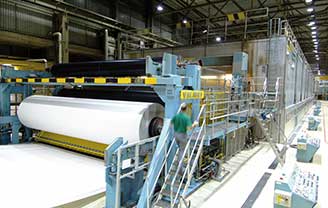
Take a look at the video above. The film was taken in the 1930s at Bathford Paper Mill (with thanks to Portals Bathford for providing the footage). You can see men in their flat caps and braces, smoking in the machine house - certainly practices that would never be allowed today!
Although the basic processes of papermaking have remained unchanged for nearly two thousand years paper, once made by hand in individual sheets, is now made on enormous papermaking machines (look at the picture on the right), four times the length of a cricket pitch. In one week a single machine can produce enough paper to stretch from London to New York.